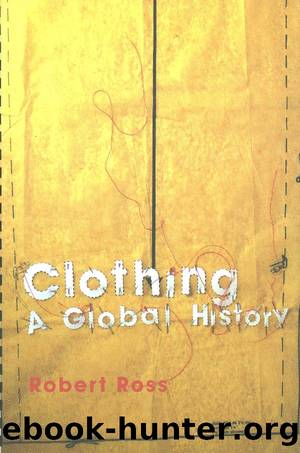Clothing: A Global History by Robert Ross

Author:Robert Ross
Language: eng
Format: epub
Publisher: Polity
Published: 2012-02-21T16:00:00+00:00
It was not always European clothing that was propagated, just as it was not always Europeans who were doing the propagating. As in most missionary fields, mass conversions were achieved only once converts were employed as the main evangelizers. In much of Polynesia, those evangelists were Tahitians, following the mass adoption of Christianity in the Society Islands during the course of the 1820s. The missionaries had asked those Tahitians who were to be baptized to cover themselves for the service. The men were to wear
a tiputa, a wrapper reaching to the middle of the leg, and the women to get a hu tipanoi, a wrapper reaching down to the foot. In the above dress, the first 14 were baptised in 1819 … more than a 1,000 were all in the old costume, except oiling the body all over on the Sabbath. But from that day they all adopted the dress of the 14 at least on the Sabbath day, and have continued to improve in clothing from that time to the present.39
As they brought their newly adopted religion to both the Cook Islands and to Samoa, they also brought new ways of dressing. In the Society Islands, it had been normal for men and women to cover the torso. It was general to wear a piece of bark cloth draped over the shoulders with a slit for the head, much as modern poncho. These then were widely adopted by the new Christian parties in the other islands.40 In the Cook Islands, culturally very much under Tahitian influence, it has been suggested that the introduction of European calicoes, which could be acquired with much less labour than bark cloth, entailed “a democratization of prosperity”. Previously the poncho had been a mark of rank, and of associated wealth.41 In Fiji, on the other hand, what was introduced was a long bark cloth skirt, for men as well as women, known as the sulu. It replaced the simple loincloth which had been worn by men before the introduction of Christianity.42 It is still worn as Fijian national dress, in one of the more obvious versions of invented traditions, though today the cloth will be cotton or other woven material. A Fijian aristocrat will even wear a pin-stripe sulu to accompany a dress coat and tie, as full court dress.43
There was a further twist to this in Hawaii. From the early nineteenth century European and American traders brought with them a whole variety of consumer goods, in particular cloth and a certain amount of made-up clothing. By 1820, when the missionaries of the American Board of Commissioners for Foreign Missions established their presence, they found that a male chief might be dressed, for instance, in “a neat white dimity jacket, black silk vest, nankeen pantaloons, white cotton stockings, shoes, plaid cravat and a neat English hat”.44 It was a way in which the Hawaiian aristocracy, newly enriched by the sandalwood trade, was able to demonstrate its importance in what Marshall Sahlins has called “the political economy of grandeur”.
Download
This site does not store any files on its server. We only index and link to content provided by other sites. Please contact the content providers to delete copyright contents if any and email us, we'll remove relevant links or contents immediately.
| Advertising | Annuals |
| Book Design | Branding & Logo Design |
| Fashion Design | Illustration |
| Science Illustration |
Wonder by R.J. Palacio(8430)
Mastering Adobe Animate 2023 - Third Edition by Joseph Labrecque(3720)
Unlabel: Selling You Without Selling Out by Marc Ecko(3574)
Ogilvy on Advertising by David Ogilvy(3485)
Hidden Persuasion: 33 psychological influence techniques in advertising by Marc Andrews & Matthijs van Leeuwen & Rick van Baaren(3454)
Drawing Cutting Edge Anatomy by Christopher Hart(3440)
The Pixar Touch by David A. Price(3347)
POP by Steven Heller(3298)
The Code Book by Simon Singh(3057)
The Art of War Visualized by Jessica Hagy(2932)
Slugfest by Reed Tucker(2924)
The Curated Closet by Anuschka Rees(2897)
Rapid Viz: A New Method for the Rapid Visualization of Ideas by Kurt Hanks & Larry Belliston(2815)
Stacked Decks by The Rotenberg Collection(2796)
365 Days of Wonder by R.J. Palacio(2737)
The Wardrobe Wakeup by Lois Joy Johnson(2717)
Keep Going by Austin Kleon(2682)
Tattoo Art by Doralba Picerno(2583)
Tell Me More by Kelly Corrigan(2579)
